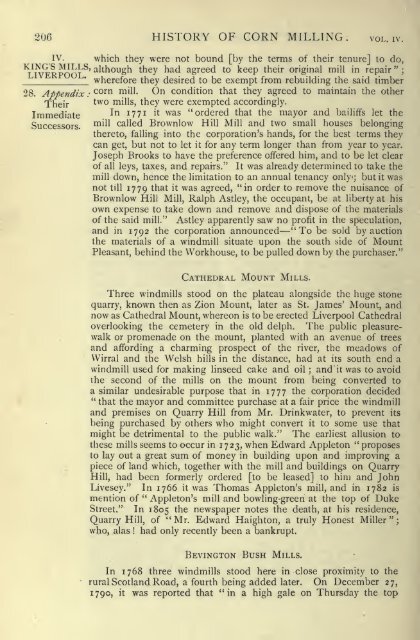History of corn milling .. - Centrostudirpinia.it
History of corn milling .. - Centrostudirpinia.it
History of corn milling .. - Centrostudirpinia.it
You also want an ePaper? Increase the reach of your titles
YUMPU automatically turns print PDFs into web optimized ePapers that Google loves.
206 HISTORY OF CORN MILLING. VOL. IV.<br />
IV. which they were not bound [by the terms <strong>of</strong> their tenure] to do,<br />
^^j!j^^^j^^^^' LIVERPOOL. although they had agreed to keep their original mill in repair";<br />
wherefore they desired to be exempt<br />
28. Appendix<br />
Their<br />
Immediate<br />
Successors.<br />
from rebuilding the said timber<br />
<strong>corn</strong> mill. On cond<strong>it</strong>ion that they agreed to maintain the other<br />
two mills, they were exempted accordingly.<br />
In 1771 <strong>it</strong> was "ordered that the mayor and bailiffs let the<br />
mill called Brownlow Hill Mill and two small houses belonging<br />
thereto, falling into the corporation's hands, for the best terms they<br />
can get, but not to let <strong>it</strong> for any term longer than from year to year.<br />
Joseph Brooks to have the preference <strong>of</strong>fered him, and to be let clear<br />
<strong>of</strong> all leys, taxes, and repairs." It was already determined to take the<br />
mill down, hence the lim<strong>it</strong>ation to an annual tenancy only; but <strong>it</strong> was<br />
not till 1779 that <strong>it</strong> was agreed, "in order to remove the nuisance <strong>of</strong><br />
Brownlow Hill Mill, Ralph Astley, the occupant, be at liberty at his<br />
own expense to take down and remove and dispose <strong>of</strong> the materials<br />
<strong>of</strong> the said mill." Astley apparently saw no pr<strong>of</strong><strong>it</strong> in the speculation,<br />
and in 1792 the corporation announced— "To be sold by auction<br />
the materials <strong>of</strong> a windmill s<strong>it</strong>uate upon the south side <strong>of</strong> Mount<br />
Pleasant, behind the Workhouse, to be pulled down by the purchaser."<br />
Cathedral Mount Mills.<br />
Three windmills stood on the plateau alongside the huge stone<br />
quarry, known then as Zion Mount, later as St. James' Mount, and<br />
now as Cathedral Mount, whereon is to be erected Liverpool Cathedral<br />
overlooking the cemetery in the old delph. The public pleasurewalk<br />
or promenade on the mount, planted w<strong>it</strong>h an avenue <strong>of</strong> trees<br />
and affording a charming prospect <strong>of</strong> the river, the meadows <strong>of</strong><br />
VVirral and the Welsh hills in the distance, had at <strong>it</strong>s south end a<br />
windmill used for making linseed<br />
the second <strong>of</strong> the mills on the<br />
cake and oil and <strong>it</strong> was to ; avoid<br />
mount from being converted to<br />
a similar undesirable purpose that in 1777 the corporation decided<br />
"<br />
that the mayor and comm<strong>it</strong>tee purchase at a fair price the windmill<br />
and premises on Quarry Hill from Mr. Drinkwater, to prevent <strong>it</strong>s<br />
convert <strong>it</strong> to some use that<br />
being purchased by others who might<br />
might be detrimental to the public walk." The earliest allusion to<br />
"<br />
these mills seems to occur in 1723, when Edward Appleton proposes<br />
to lay out a great sum <strong>of</strong> money in building upon and improving a<br />
piece <strong>of</strong> land which, together w<strong>it</strong>h the mill and buildings on Quarry<br />
Hill, had been formerly ordered [to be leased] to him and John<br />
Livesey." In 1766 <strong>it</strong> was Thomas Appleton's mill, and in 1782 is<br />
mention <strong>of</strong> " Appleton's mill and bowling-green at the top <strong>of</strong> Duke<br />
Street." In 1805 the newspaper notes the death, at his residence.<br />
Quarry Hill, <strong>of</strong> "Mr. Edward Haighton, a truly Honest Miller";<br />
who, alas ! had only recently been a bankrupt.<br />
Bevington Bush Mills.<br />
In 1768 three windmills stood here in close proxim<strong>it</strong>y<br />
to the<br />
rural Scotland Road, a fourth being added later. On December 27,<br />
1790, <strong>it</strong> was reported that "in a high gale on Thursday the top

















